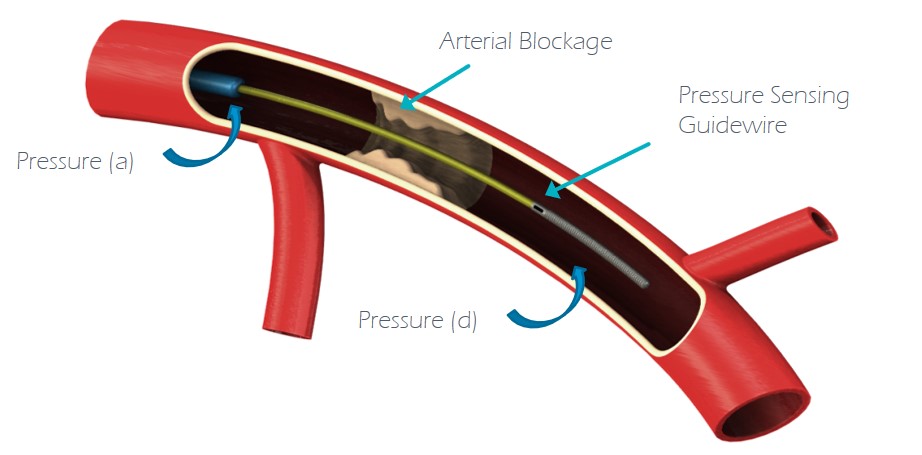

FFR Introduction
Fractional Flow Reserve (FFR) is the gold standard for assessing the significance of ischemia-inducing arterial stenoses through an invasive guidewire-based procedure that can accurately measure blood pressure and flow through a specific part of an artery.
A pressure-sensing guidewire measures pressures distal (after) and proximal (before) to an arterial blockage. The ratio of the distal pressure to the proximal pressure is the FFR.


The lower the ratio, the greater the blockage of blood flow. In medical guidelines, an FFR less than 0.80 requires intervention.
Landmark Clinical Trials on Fractional Flow Reserve
FAME 2 Trial
First published in the New England Journal of Medicine in 2012
The FAME 2 trial was conducted at 28 sites in Europe and North America. Between May 2010 and January 2012, a total of 1,220 patients with stable coronary artery disease were enrolled (with 888 undergoing randomization).
The trial was designed to determine if FFR-guided PCI¹ plus optimal medical therapy (OMT) would be superior compared to OMT alone in treating patients with stable functionally significant coronary stenoses.
The FFR-guided PCI group showed significantly superior results in reducing MACE², compared to the OMT alone group. The overwhelming evidence prompted the independent Data and Safety Monitoring Board to recommend the early termination of the trial. After 5 years, the clinical follow-up of patients showed MACE remained significantly lower in the FFR-guided PCI group than in the OMT group. Patients without hemodynamically significant stenoses had a favorable long-term outcome with OMT alone.
References:
FAME Trial
First published in the New England Journal of Medicine in 2009
The initial FAME trial was conducted in 20 sites in Europe and North America. Between January 2006 and September 2007, a total of 1,005 patients with multi-vessel coronary artery disease were enrolled.
The trial was designed to determine if FFR-guided PCI in addition to angiography improves clinical outcome as compared to angiography-guided only PCI. Patients randomly assigned to the angiography-guided only PCI group underwent stenting of all indicated lesions, whereas those assigned to the FFR-guided group underwent stenting of indicated lesions only if the FFR was ≤ 0.80.
MACE in the FFR-guided group was significantly lowered than the angiography-guided group. After 5 years, MACE remained lower in the FFR-guided group versus the angiography-guided group. This clinical outcome in the FFR-guided group was achieved with a lower number of stented arteries and less resource use. These results suggest that FFR guidance of multivessel PCI should be the standard of care in most patients.
References:
DEFER Trial
First published in the American Heart Association Circulation Journal in 2001
The DEFER trial was conducted in 14 sites in Europe and Asia. Between June 1997 and December 1998, a total of 325 patients who had been referred for elective PCI of an intermediate stenosis and had no recent documented ischemia were enrolled.
The purpose of the DEFER trial was to investigate whether it is beneficial to stent functionally non-significant stenosis, as derived by FFR.
FFR was measured for the enrolled patients just before the planned intervention. If FFR was <0.75, PCI was performed as planned. If FFR was ≥ 0.75, patients followed their randomization to the Defer group (where PCI was deferred), or to the Perform group (where PCI was performed).
Clinical follow-up on patients were obtained after one, two and five years. Five-year outcome after deferral of PCI based on FFR ≥0.75 was excellent, with event-free survival not different between the Defer and Perform groups, but significantly worse in the Reference group. After 15 years, the rate of death was not different among the three groups and the rate of myocardial infarction was significantly lower in the Defer group compared with the Perform group. This landmark trial demonstrated that in patients with a coronary stenosis without evidence of ischemia, FFR safely identifies those who will benefit from intervention, and that utility of FFR is associated with a favorable very long-term follow-up without signs of late ‘catch-up’ phenomenon.
References:
1.
Percutaneous coronary intervention.
2.
Major adverse cardiovascular events, including death, myocardial infarction or urgent revascularization.